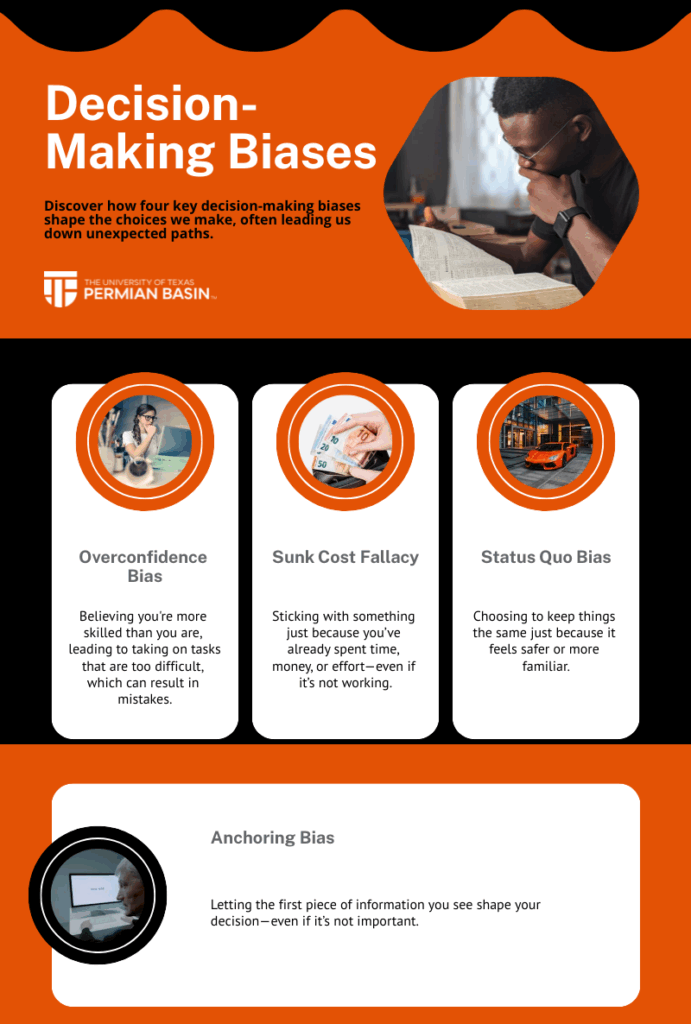Every day, your brain processes an astonishing 11 billion bits of information per second. With so much going on behind the scenes, it leans on mental shortcuts—known as cognitive biases—to make decisions more efficiently. While these shortcuts can be helpful, they don’t always lead to the best outcomes.
One specific category, decision-making biases, affects how we choose between options, especially in uncertain or high-stakes situations. Let’s explore what decision-making biases are and look at four common types that influence your daily choices.
What Is a Decision-Making Bias?
A decision-making bias is a type of cognitive bias that influences how we choose between options, especially in uncertain or high-pressure situations. These mental shortcuts help us make quicker decisions, but that doesn’t mean they always lead to the best outcomes.
In fact, they often don’t.
Decision-making biases can be harmless. Take deciding what to eat for dinner, for example. To help you reach a quick and easy conclusion, you might choose one of your favorite go-to options.
However, there are times when your brain’s attempt to simplify your choices can lead to less rational decisions: for example, feeling confident enough to make Julia Child’s coq au vin from scratch, even though you normally struggle not to burn grilled cheese sandwiches.
4 Types of Decision-Making Biases
Below, we discuss four of the common decision-making biases that help you shape your choices throughout the day.
#1 Overconfidence Bias
Overconfidence bias can lead to overestimating your skills in a particular area, whether it be cooking dinner, renovating the bathroom, or assembling your little one’s new state-of-the-art playset.
Let’s take the coq au vin example above. While you may not naturally be the head chef in your kitchen, you might feel like a culinary artist after watching hours of “Top Chef” reruns over the weekend. With an artificially inflated ego, coq au vin suddenly seems like an easy dinner solution, even though, in reality you usually struggle to boil pasta without checking the directions twice.
#2 Sunk Cost Fallacy
The sunk cost fallacy is a decision-making bias that occurs when you continue to invest in an endeavor based on the resources you’ve already committed.
Let’s pretend it’s New Year’s, and you’ve decided to purchase an annual gym membership. It’s a large sum of money upfront, but you’re dedicated to your fitness journey.
Fast forward a few months. The passion is gone, and though you dread the thought of sliding your feet into your tennis shoes time and time again, you continue to go to the gym.
Why? Simply because you’ve already paid for the entire year.
Even if cutting your losses is the more rational decision, you’re more likely to keep investing your time because you’ve committed too much money and effort.
#3 Status Quo Bias
The status quo bias affects our decisions by making us inclined to stick with our current situation. We often choose to stay the same because we fear change or have grown used to doing things a certain way.
For instance, your doctor might suggest a new medication that provides better health benefits than the one you’ve been taking. However, the status quo bias may rear its ugly head, reminding you that you’ve been fine with your current medication for years, so why switch it up now?
#4 Anchoring Bias
Have you ever locked eyes with the most expensive item on the menu? It seems stiflingly high at first, but after a few moments, it becomes the anchor item on the menu. Suddenly other plates seem more reasonable, even if they’re still priced higher than usual.
Welcome to the anchoring bias, which occurs when you find an initial piece of information and rely heavily on it when making subsequent decisions. While your anchor may be irrelevant to your final choice, it exhibits a strong influence on your decision, nonetheless.
Make the Decision That’s Right for You at UTPB
With The University of Texas Permian Basin’s online Bachelor of Arts in Psychology, your higher education decision is simple. Our program offers online students plenty of benefits:
- Flexibility: Complete your coursework wherever you want within a timeframe that works for you.
- Affordability: We’re ranked the #2 Most Affordable Online Psychology Degree by STEPS.
- Networking: Meet virtually with distinguished professors and other like-minded students from around the country, expanding your network and potential career opportunities.
Take the first step toward deciding your future and apply today!
Don’t miss part two of our series on cognitive bias, where we’ll discuss social biases and how they influence the way we behave and perceive ourselves and others.
Sources:
https://www.forbes.com/sites/daviddisalvo/2013/06/22/your-brain-sees-even-when-you-dont/?sh=26e4097d116a
https://www.masterclass.com/articles/overconfidence-bias
Other articles you may be interested in:
-
When the final “ber” months roll around, the world wraps itself in holiday cheer. Families make travel plans, calendars fill with festive gatherings, and store shelves overflow with stocking stuffers and seasonal treats. But behind the twinkle lights and snow-covered commercials, the holidays can be a stressful time. According to the American Psychological Association, 41%…
-
Does your pulse race at the thought of glancing out of a plane window at 30,000 feet? How about swimming through shark-infested waters? Or delivering a speech to a roaring crowd? While a fear of heights, sharks, or public speaking is normal, most people won’t be diagnosed with a phobia of these common fears. To…
-
What compels someone to commit a violent crime—or repeatedly break the law? Is it a mental illness, unresolved childhood trauma, or something else entirely? The FBI reported that in 2017, violent crimes occurred every 24.6 seconds in the United States, including a murder every 30.5 minutes, a rape every 3.9 minutes, and a robbery every…
